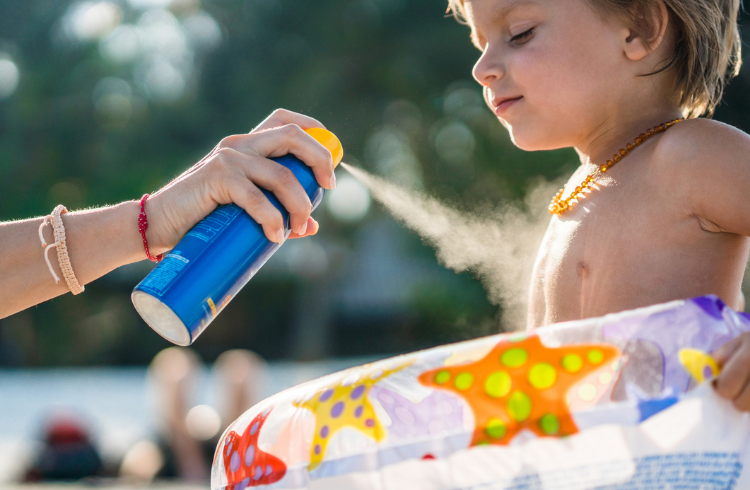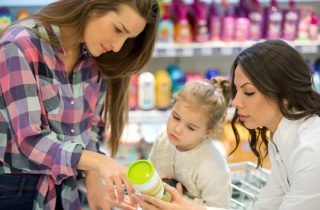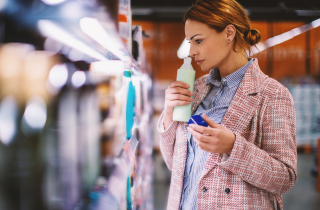Cosmetic Hazardous Ingredient Right to Know Act
At a Glance
The Cosmetic Hazardous Ingredient Right to Know Act (HR 4435), introduced in the U.S. House of Representatives by Rep. Schakowsky (D-IL) and Rep. Matsui (D-CA), would require the disclosure of the secret, unlabeled, and often toxic fragrance and flavor chemicals in our beauty and personal care products on product labels and brand owner websites.
The bill also requires companies to provide website links where consumers can obtain more information about any ingredient in a cosmetic product that negatively impacts human health. It would apply to both retail consumer products and professional salon products.
This bill is part of the Safer Beauty Bill Package, four bills that will make beauty and personal care products safer for all by banning the worst chemicals, requiring disclosure of hazardous chemicals (including fragrance ingredients), protecting women of color and salon workers, and requiring supply chain transparency.

Problem
Thousands of synthetic chemicals are used to create the fragrance and flavor ingredients in beauty and personal care products we use every day. Some of these chemicals have been linked to negative health impacts ranging from allergic reactions to reproductive harm to increased risk of breast cancer however, a federal labeling loophole means these often unsafe chemicals can hide under the word “fragrance” or “flavor” on product labels.
The widespread marketing and use of fragranced cosmetic products adds to the problem. Fragrance chemicals are found in more than 95% of personal care products[i] such as shampoos, conditioners, hair styling products, antiperspirants, and shaving products, as well as fine fragrances, body sprays, and lotions, and even make-up. In a national survey, over 34% of respondents in the U.S. reported health problems, such as migraine headaches and respiratory difficulties, in response to exposure to fragranced products.[ii]
According to a recent analysis of the International Fragrance Association’s (IFRA) Transparency List – a compilation of chemicals used by fragrance houses from around the world – over 98% of fragrance chemicals currently in use either have significant gaps in available hazard data or are considered to be of high or potentially high concern by authoritative scientific bodies.
Fragrance chemicals also pose significant occupational risks. Professional salon workers are disproportionately exposed to fragrances in the workplace. Hairdressers and beauticians have a 47-fold higher risk[v] of fragrance skin allergies than people in other occupations. The California Work-Related Asthma Prevention Program has documented that the use of fragranced products in the workplace is associated with work-related asthma.[vi]
Chemicals intended to impart flavor can also have harmful health impacts. Thirty-eight flavors listed on the International Organization of the Flavorings Industry (IOFI) list are on the California Department of Toxic Substances Control’s Candidate Chemicals List, linking them to human health or environmental harm.[vii] This includes ten flavor ingredients listed as carcinogens or reproductive toxicants by California Proposition 65.[viii]
Other hazardous ingredients
Aside from the fragrance and flavor chemicals, other hazardous ingredients used as surfactants, emollients, pigments, preservatives, and more can be found in personal care and beauty products, both as intentionally added chemicals as well as contaminants.
For example, lip, eye, and other face and nail products often contain pigments (a.k.a colorants) which can be contaminated with lead and other heavy metals linked to cancer, brain damage, and organ system toxicity.
Sunscreens can contain ultraviolet filters, or UV filters — chemicals that screen out UV-A and UV-B rays from the sun, such as octinoxate, octyl methoxycinnamate, benzophenone, oxybenzone, PABA, and padimate O. Benzophenone and oxybenzone are considered PBTs because they are persistent, bioaccumulative, and toxic.[ix,x] While others are linked to cancer, endocrine disruption, and organ system toxicity.
Carcinogens and endocrine-disrupting compounds like formaldehyde-releasing preservatives, parabens, and butylated hydroxyanisole (BHA) and butylated hydroxytoluene (BHT) are used as preservatives in a variety of personal care products, including body care and hair care products.
Current market trends and state laws
The disclosure of hazardous fragrance and flavor ingredients in personal care and beauty products is already happening nationwide. Multinational giants like Proctor & Gamble, Unilever, and Johnson & Johnson voluntarily disclose fragrance ingredients at or above 100 parts per million, and hundreds of clean cosmetic companies fully disclose fragrance ingredients.
An industry best practice, the disclosure of harmful fragrance and flavor ingredients in beauty and personal care is also the law in California.[xi] Two states – California[xii] and New York[xiii] – require even stronger fragrance ingredient disclosure for cleaning products. Furthermore, the fragrance and flavor ingredients publicly disclosed via the California Cosmetic Fragrance and Flavor Ingredient Right to Know Act of 2020[xiv] are no longer eligible for trade secret protection. This is because once they are publicly disclosed, they are no longer a secret.
Policy Gaps
No federal law currently requires the disclosure of fragrance or flavor ingredients to consumers. This loophole allows dozens – sometimes even hundreds – of chemicals to hide under the word “fragrance” on the labels of beauty and personal care products with no regulatory oversight of the safety of those ingredients. The same loophole exists for flavors, which frequently appear in products like flavored lip gloss and chapsticks marketed to children. Moreover, this loophole also applies to other hazardous ingredients in cosmetic products
And no state or federal law requires companies to tell consumers if other hazardous ingredients are lurking in their cosmetic products. As a result, anyone using beauty or personal care products is at risk of being exposed to secret hazardous chemicals – including fragrance and flavor ingredients – without their knowledge or consent, linked to harmful chronic health concerns, which is even more or a problem for vulnerable populations such as babies, children, communities of color, professional salon workers, and pregnant women.
The presence of unknown, unlabeled toxicants is cause for serious concern because scientific evidence suggests that hazardous chemical exposures in our everyday lives harm human and environmental health.
Solution
The Cosmetic Hazardous Ingredient Right to Know Act of 2025 requires:
On-pack and website disclosure of hazardous chemicals in a beauty or personal care product. Brand owners must disclose for each product
On a cosmetic company’s website:
- A full list of ingredients, including fragrance and flavor ingredients, in descending order of predominance.
- The functional purpose of each fragrance or flavor ingredient.
- A link to the safety data sheets (SDS) for products intended for professional use.
- For any ingredient that is scientifically linked to a negative impact on human health, brand owners must provide a website link to any of the 21 lists of toxic chemicals from respected state, federal, and international governmental or scientific bodies referenced by the bill.
On the product packaging or labeling:
- A full list of ingredients, including fragrance and flavor ingredients, in descending order of predominance.
- A statement directing consumers to the brand owner’s website for health impact information related to any hazardous ingredients in the product.
For more information, contact:
Janet Nudelman, Breast Cancer Prevention Partners, Janet@BCPP.org
Footnotes
[i] Prevalence of Cosmetic Allergens; Journal of Clinical and Aesthetic Dermatology
[ii] Fragranced consumer products: exposures and effects from emissions; Air Quality, Atmosphere & Health International Journal
[iii] Unpacking the Fragrance Industry
[iv] Right to Know: Exposing toxic fragrance chemicals in beauty, personal care and cleaning products
[v] Montgomery RL, Agius R, Wilkinson SM and Carder M. (2018) UK trends of allergic occupational skin disease attributed to fragrances
[vi] CDPH Fragrances and Work-Related Asthma
[vii] Women’s Voices for the Earth – comparison of SB312 reportable ingredients to IOFI flavor palette (2019)
[viii] Women’s Voices for the Earth – comparison of SB312 reportable ingredients to IOFI flavor palette (2019)
[ix] Brooks AC., et al. (2009). Importance of prey and predator feeding behaviors for trophic transfer and secondary poisoning. Environ Sci Technol, vol. 43, no. 20, pp 7916–7923, 2009.
[x] Kim S. & Choi K., Occurrences, toxicities, and ecological risks of benzophenone-3, a common component of organic sunscreen products: A mini-review. Environment International, vol. 70, pp 143-57, 2014.
[xi] Bill Text – SB-312 Cosmetic Fragrance and Flavor Ingredient Right to Know Act of 2020. (ca.gov)
[xii] Bill Text – SB-258 Cleaning Product Right to Know Act of 2017. (ca.gov)
[xiii] Household Cleansing Product Information Disclosure Program – NYS Dept. of Environmental Conservation
Types: Fact Sheet





